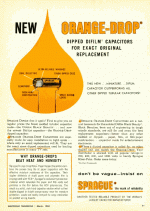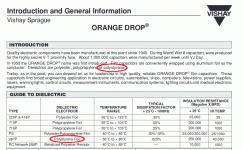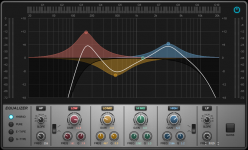Agreed! That means it might be ok if a ceramic disk cap in the signal path achieves the desired result. Look at this waveform from a cap comparison test of the disk type after the comment,....if it sounds right, it is right. Arc or no arc!
-Gnobuddy
"Such devices have no place in any audio system. So take care if offered a small ceramic disc, having significantly greater capacitance than the few hundred pF found in conventional ‘Type 1’ ceramic disc capacitors."
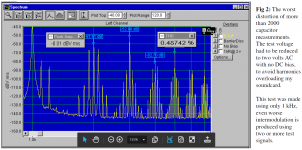
The whole comparison test: View attachment Capacitor Sounds -Bateman 2003 caps 100 nF to 1uF.pdf
Bateman's work came up earlier in this thread. I looked at some of his measurements, and the ones I looked at showed distortion levels hundreds or thousands of times below the threshold of detectability, and therefore, utterly irrelevant.it might be ok if a ceramic disk cap in the signal path achieves the desired result.
This particular example - 0.48% THD, the very worst he could manage to drum up - is right at the threshold of detectability by the human ear. The lowest distortion that was detected at a statistically significant level, in properly controlled double-blind listening tests, was about 0.5%. That was using a pure sine-wave signal; with music, 0.5% THD was completely inaudible.
So feel free to use this "terribly bad" ceramic cap in any guitar amp. With a guitar as signal source, and a guitar speaker at the other end of the amp, I'll bet that the 0.48% THD is undetectable by human ears - it could barely be detected with Hi-Fi speakers and a pure sine wave input, it certainly won't be detected with a distorted source (guitar pickup) through heavily compromised speakers (any guitar speaker.)
For reference: a half-12AX7 triode gain stage operated completely "clean", will typically generate 5% THD, ten times more than the most "evil" ceramic cap Bateman found. And we hear even that as "clean" in a guitar amp.
How about for Hi-Fi? There I agree with Bateman's conclusion. THD for the entire electronics chain should be 0.1% or below if possible, so we don't want a single cap generating 0.5% THD.
-Gnobuddy
Yes, but do not THD values belie dynamic considerations, such as the effect of distortion stages discussed previously, and the inconsistent distortion in the waveform above? What I'm saying is that the ceramic cap is virtually unnoticeable according to THD in a guitar amp, but there are some who say their amp sounds too sterile, so they add carbon comp resistors in the signal path or maybe the plate to get some "fizz". This is probably indiscernible to most people, but most people don't play high gain guitar.....For reference: a half-12AX7 triode gain stage operated completely "clean", will typically generate 5% THD, ten times more than the most "evil" ceramic cap Bateman found. And we hear even that as "clean" in a guitar amp.....
-Gnobuddy
My Hammond H-100 has nothing but carbon comp resistors and disk caps, and sounds awesome. If I "cleaned" up the signal, it might very well sound like like a $50 Casio. The tube amp is also over-driven slightly which makes it sound more "angry" or "aggressive", especially with the volume up and many draw-bars out. It's almost Jon Lord with Deep Purple sounding. It will not be touched!
But I get what you're saying. If I change the electrolytic signal caps in the fuzz box with film, or replace some lower values with disks, it won't be discernible even to me who is listening for it. The same would go for a over-driven tube amp, as you implied, except "clean" in tube is nowhere near a sterile setup like running a guitar through a HiFi, as long as it's not over-driven with the signal.
Last edited:
Humbucker Buffer/25k Volume Pot Update
There is no noise at all now so a gate is not required for hiss, at least. It's so low that it seems unreal. There is no discernible difference between the TL071 and the OPA1641 in terms of noise (in this context), but there was an ever so slight sound quality increase with the 1641. I used the Gotoh battery box because the others are rubbish.
Same goes for the capacitor types. I would throw in polypropylene on a top end guitar only. The orange drops are huge and would be a tight fit in most fuzz boxes, and wouldn't fit at all is some. But if there are other boxes in the chain that don't use them, I fail to see the advantage, except for peace of mind, and the awe of seeing the orange color with the covers off.
The first opamp in the box was upgraded from 4558 to 2114 which helped very slightly with noise. The 2114 is not recommended for apps that require a unity gain buffer without adding an input resistor, or else burn on startup. In that case the 2068 could be used as an upgrade if it's not feasible to add the resistor.
Further hiss reduction could be achieved with the use of the HB single coil mod, but this would be minimal. Reason being the 500k pot was the major problem at mid resistance point.
The DADGAD was tried with the fuzz box cranked and sounds pretty good. The neck bowed and had to be adjusted due the relaxed tension. Can't play too many strings just like in any tuning, but if a mistake is made, it won't sound too bad. Moreover, slide may be played with that tuning.
The pickup screws were adjusted for arc and the center two string sound more alive to a significant degree.
There is no noise at all now so a gate is not required for hiss, at least. It's so low that it seems unreal. There is no discernible difference between the TL071 and the OPA1641 in terms of noise (in this context), but there was an ever so slight sound quality increase with the 1641. I used the Gotoh battery box because the others are rubbish.
Same goes for the capacitor types. I would throw in polypropylene on a top end guitar only. The orange drops are huge and would be a tight fit in most fuzz boxes, and wouldn't fit at all is some. But if there are other boxes in the chain that don't use them, I fail to see the advantage, except for peace of mind, and the awe of seeing the orange color with the covers off.
The first opamp in the box was upgraded from 4558 to 2114 which helped very slightly with noise. The 2114 is not recommended for apps that require a unity gain buffer without adding an input resistor, or else burn on startup. In that case the 2068 could be used as an upgrade if it's not feasible to add the resistor.
Further hiss reduction could be achieved with the use of the HB single coil mod, but this would be minimal. Reason being the 500k pot was the major problem at mid resistance point.
The DADGAD was tried with the fuzz box cranked and sounds pretty good. The neck bowed and had to be adjusted due the relaxed tension. Can't play too many strings just like in any tuning, but if a mistake is made, it won't sound too bad. Moreover, slide may be played with that tuning.
The pickup screws were adjusted for arc and the center two string sound more alive to a significant degree.
Congratulations on a happy end to your quest!There is no noise at all now so a gate is not required for hiss, at least.
Orange drops are polyester, polypropylene, or polystyrene film caps (do they use whatever dielectric is cheapest that month?): https://www.vishay.com/docs/42015/intro.pdfI would throw in polypropylene on a top end guitar only. The orange drops are huge...
In 1959, these film caps would have been something special, more stable and longer-lasting than some previous primitive-technology capacitor types (such as paper in oil.) Today, they're just incredibly oversized, ludicrously overpriced, plastic film caps. As far as audio circuits go, they're identical to all the other much smaller, much cheaper, film caps you can find at any major electronics supplier. (But they'll lighten your bank balance quite a bit more, if you need help in that department.
Exactly! Like the comforting orange glow from the amber LED mounted under the non-functioning "tube" in some of those "tube" preamps....I fail to see the advantage, except for peace of mind, and the awe of seeing the orange color with the covers off.
Mebbe if I got myself a can of orange spray paint, and painted my ceramic caps orange? "Orange disc" caps, anyone? As used by the great Jimi Hendrix, the caps which gave him his unique guitar tone?
With the 500k pot at mid-resistance, guitar output impedance is a bit more than 125k (one quarter of 500k) at DC, and more at the pickup resonance, but never more than 250k, worst case....the 500k pot was the major problem at mid resistance point.
Dropping from 250k to 25k is a ten-fold reduction in resistance. Dropping from 125k to 25k is a five-fold reduction in resistance. All else being the same, thermal noise voltage goes as the square root of resistance, so it will drop by a factor of roughly 3.16 (the square root of 10) near the pickup resonant frequency, and by roughly 2.24 (the square root of 5) at frequencies well below pickup resonance.
In decibels, that's roughly 7 dB to maybe almost 10 dB less thermal noise from the guitar, depending on the frequency. That's a not inconsiderable improvement - the Dolby B noise reduction system only managed 10 dB, and it used quite a complex circuit for its time. IIRC there were some 10 transistors and 2 JFETs required, along with a double handful of resistors and caps and trimpots and diodes. (I built the discreet version of the circuit, in stereo, because I couldn't get hold of the rare and expensive officially licensed Dolby B NR integrated circuit.)
So, getting 7 - 10 dB of hiss reduction from just a pot change is quite a nice gift from mother nature.
Of course, the rest of the circuit has to be good enough not to muck up the hard-won few decibels of noise reduction. IIRC we calculated a 2.5 dB noise figure for the TL072 with a 20k source impedance, so it is just possible to do a tiny, tiny, bit better with a lower-noise op-amp.
The seven diatonic major scale notes in the key of D-major are D, E, F#,G, A,B, and C#....DADGAD...
That means D,G,and A (the three notes in the DADGAD tuning) are the first, fourth, and fifth notes in the scale. In other words, DADGAD is just a six-string Dsus4 chord.
I like sus4 and sus2 chords for "colour", and frequently use the 5-string Dsus4 and Dsus2 chords down at the second position when playing in the keys of D major, G major, or A major. Strictly speaking, they are Dsus4/A and Dsus2/A chords.
Esus4 is a nice, easy, three-finger, six-string chord down at the 2nd fret, as easy as the "cowboy chord" A-major. If you play the Esus4 with middle, ring, and pinky fingers, your index finger is free to use as a barre', and now you have a nice six-string, movable sus4 chord (what the jazz guys call a "movable grip"), with the root on the 6th string, that you can play all over the neck, getting all twelve sus4 chords for the price of one, without having to retune the guitar.
Asus4 (three fingers, six strings, down at the 2nd fret) also becomes a movable chord shape if you add a barre and play it with all four fingers of your chording hand. Once again, you have all twelve sus4 chords for the price of one, without having to retune the guitar.
There is a six-string, two-finger, E7sus4 chord at the 2nd position, when you want a bit more texture than just a plain sus4. It's also easily modified into a movable chord shape by adding a barre. (I think this is the one used at the end of the intro in the Peter, Paul, and Mary song "California Dreamin' ".)
-Gnobuddy
> Orange drops are polyester, polypropylene, or polystyrene film caps (do they use whatever dielectric is cheapest that month?)
The code number like "716P" TELLS you what the cap is made of.
I do not see polystyrene on the list; never heard of PS ODs.
They were early plastic-film caps--- actually they started as "DiFilm", paper with polyester. They were not the first plas-caps, but Sprague marketed the heck out of them, for production and as Service Replacements for jobs where paper caps didn't hold-up, and pushed them onto distributor and repair-shop shelves. They were semi-premium (more costly than paper or most copycat plastics) and got sold into military/industrial designs (hence the specs). They seem to have been follow-up for Black Beauty, Yellow Jacket, and Vitamin Q, older "good" caps which today have usually perished; ODs seem to hold-up decades.
The code number like "716P" TELLS you what the cap is made of.
I do not see polystyrene on the list; never heard of PS ODs.
They were early plastic-film caps--- actually they started as "DiFilm", paper with polyester. They were not the first plas-caps, but Sprague marketed the heck out of them, for production and as Service Replacements for jobs where paper caps didn't hold-up, and pushed them onto distributor and repair-shop shelves. They were semi-premium (more costly than paper or most copycat plastics) and got sold into military/industrial designs (hence the specs). They seem to have been follow-up for Black Beauty, Yellow Jacket, and Vitamin Q, older "good" caps which today have usually perished; ODs seem to hold-up decades.
Attachments
Orange drops are polyester, polypropylene, or polystyrene film caps (do they use whatever dielectric is cheapest that month?): https://www.vishay.com/docs/42015/intro.pdf
There is a six-string, two-finger, E7sus4 chord at the 2nd position, when you want a bit more texture than just a plain sus4. It's also easily modified into a movable chord shape by adding a barre. (I think this is the one used at the end of the intro in the Peter, Paul, and Mary song "California Dreamin' ".)
-Gnobuddy
Thanks for the correction with the caps. Better to consider the dielectric when discussing (and ordering). The COGs are really good according to Bateman. But I could not find the values required for the MT-2; polystyrene is even harder to find. In any case, I will try a nasty Type 1 ceramic in the box's incoming low pass, with an a/b switch to make it more scientific. And maybe even a carbon comp there, too, for that magic sparkle.
All the aluminum elecrolytics (1u and 10u) directly in the signal path have been replaced with film (.68u) and solid al electrolytic (10u). I was wary of oxide layer depletion due to the low voltage across those caps, reasoning the value would decay over time. They might be valued so large it would never make a difference in my lifetime (and probably the next), but it wasn't a big deal.
What you are saying with the the DADGAD applies more with acoustic or clean electric. Heavy fuzz with three strings becomes troublesome in certain instances, and worsens with more strings. I have not messed with it too much as my testing axe is now the most prevalent trouble spot. It goes out of tune and just sounds bad. There is also some buzzing, and raising the action changes the results of intonation adjustments. It's great for learning luthier work before one fiddles with a $600 custom neck, for instance.
"California Dreamin'" is a song written by John Phillips and Michelle Phillips and was first recorded by Barry McGuire. However, the best-known version is by the Mamas and the Papas, who sang backup on the original version and released it as a single in 1965.
The 716P and 215P have a "polarity" mark on one side, or if they don't it can be determined by holding it with one hand, essentially making an antenna. The results will show on a scope or heard through an amplifier. I learned this is the side of the outer foil, which may function as a shield. So in say a cathode bypass in a high gain, we would connect this side to ground. Otherwise......> Orange drops are polyester, polypropylene, or polystyrene film caps (do they use whatever dielectric is cheapest that month?)
The code number like "716P" TELLS you what the cap is made of...
They are also non-inductive, which sound to me it would be a consideration in high frequency filters, but I wonder if that feature would make any meaningful difference in guitar amps.
Take a look at the Jensen Mod 5-30 below. I don't know too much about speakers, but if comparing the cone areas, 6 of these would about equal the area of a 12" speaker. It is my understanding that given the same wattage, larger cones or more speakers will yield a higher SPL that we hear. In other words, more air molecules are exited and is consequently louder. I tried this speaker and it sounds great with or without distortion.That depends on your ears. Generally I would suggest 20kHz being enough. And if we consider guitar amplification: Typical 12" guitar speakers end at about 5~7kHz.
A good approach is the a-weighting filter that is used since decades for such measurements.
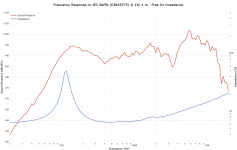
Maybe you mean 4k and 8k DCR?I was following this, but I got lost when I heard the guitar only had a pickup Z of 4k....
All of mine are >8k, both Humbuckers and single coil.
Impedance is WAY higher, quite complex (inductive plus resonant peak within the audible band) and best loaded with a very high Z, typically 470k to 1M
See attachment. Welcome to the new Orange Drops, apparently not the same as the old Orange Drops.I do not see polystyrene on the list; never heard of PS ODs.
-Gnobuddy
Attachments
Apparently also vaporware. Not available at Mouser or DigiKey.See attachment. Welcome to the new Orange Drops, apparently not the same as the old Orange Drops.
And this is a great example of widely varying personal tastes in guitar sound....Jensen Mod 5-30...sounds great with or without distortion.
That little 5" speaker goes up to above 12 kHz with almost no treble roll-off. I know without a doubt that a distorted guitar through that speaker would sound absolutely horrific to my ears, horrific to the point of forcing me to put my fingers in my ears and run out of there as fast as possible to avoid actual physical pain.
Even clean electric guitar doesn't need anywhere near that bandwidth. Not even jangly steel-string acoustic guitar needs that much!
Craig Anderton has a nice article on applying corrective EQ to electro-acoustic guitars with piezo pickups, in order to make them sound a bit more like a microphone in front of an acoustic guitar. A big part of the reason piezo pickups sound so bad is that they have too wide a treble response - they produce far more high-frequency content than you'd get from a microphone in front of the same guitar.
Anderton's entire article is well worth a read ( Better Sound from Acoustic Guitar Piezo Pickups - Guitars - Harmony Central ), but the attached image shows the EQ curve Anderton came up with for a Gibson J45. Note that he's cutting treble quite steeply above 3 kHz!
A couple of years ago, before I found the Anderton article, I designed and built a solid-state guitar amp to give to a friend living on a small disability pension. Clean tones from my humbucker-equipped Epiphone guitar started out harsh in my initial prototype, like every analog solid-state guitar amp I've ever heard.
I finally got rid of the harshness by building a fairly complex active EQ curve into the preamp - it required a gentle bass rise below about 500 Hz, a small dip at about 800 Hz, and a steep rolloff above about 2 kHz, to get the clean tones to sound good.
I was quite shocked at how low a frequency that 2 kHz rolloff was , but my ears said it sounded right. Quite a long time afterwards, I ran across Anderton's article, and it was interesting to see that he was applying a quite similar EQ curve, this time to a piezo pickup.
In my limited experience, a lot of amateur and semi-pro guitarists use far too much treble in their live sound, punishing their audience's ears. One of the biggest differences I notice between live electric guitar tone, and electric guitar sounds in a well produced recording, is that the recording usually has far, far less treble.
IMO this is another reason why it's interesting to listen to videos and sound clips from top-notch professional studio musicians like Tim Pierce. Those guys don't make the same tonal mistakes in their live video demos. Their live tone is a lot closer to the sounds you hear in a good recording. (I suppose they could be producing the heck out of their live demos after the fact, but I doubt it.)
-Gnobuddy
Attachments
That's why there's tone stacks. Reverb and echo smooth things out a bit, too. Humbuckers are dark so that speaker will make those attenuated highs available.And this is a great example of widely varying personal tastes in guitar sound.
That little 5" speaker goes up to above 12 kHz with almost no treble roll-off. I know without a doubt that a distorted guitar through that speaker would sound absolutely horrific to my ears, horrific to the point of forcing me to put my fingers in my ears and run out of there as fast as possible to avoid actual physical pain.
-Gnobuddy
The additional harmonics from distortion are rather attenuated as they go up in frequency, so pain is doubtful. I would rather have another option than not, even if it's not used all the time.
Nope. Tone controls provide a first-order treble cut (-6 dB/octave). A guitar speaker has a fourth-order treble cut (-24 dB/octave) above resonance. Tone controls are completely inadequate to simulate loudspeaker roll-off.That's why there's tone stacks.
For your ears and your brain, I believe you. For mine, pain is 100% guaranteed with that speaker and heavy distortion. (Shudders at the thought.)...so pain is doubtful.
One man's meat is another man's poison, as my mom used to say.
-Gnobuddy
That is a good adage that everyone should consider in all spheres of thought and interaction. Eddie Van Halen used to put acoustic shields in front of his amps to protect those in the first few rows from ear damage--those who weren't drugged, at least.One man's meat is another man's poison, as my mom used to say.
-Gnobuddy
That's because there's not enough demand. For enough money, that vapor would materialize rather quickly.....Apparently also vaporware. Not available at Mouser or DigiKey.
When guitar amp DIYers say "Orange Drop", the usual connotation is PP.
Some drugs, especially alcohol, numb the senses so the inflicted do not realize their ears are being damaged. I have seen the inebriated sit in 500w bass crossover cabinets for quite some time...... Van Halen put the shields up because it received complaints and to avoid lawsuits.> to protect those in the first few rows from ear damage--those who weren't drugged, at least.
Drugs don't protect your ears. In studies of hearing loss, they drug cats unconscious, expose to big sound for several hours, then measure hearing loss.
> the inflicted do not realize their ears are being damaged.
I know what you said. I know _I_ have over-exposed after I over-indulged. There may be people who think "It don't hurt!"
It happened I had just come across the experiment where cats showed hearing-shift after hours of loud sound while knocked-out. I suppose the cats were drugged so they didn't tear the cages apart while being abused. (I'm not happy about this but it wasn't my idea.)
I know what you said. I know _I_ have over-exposed after I over-indulged. There may be people who think "It don't hurt!"
It happened I had just come across the experiment where cats showed hearing-shift after hours of loud sound while knocked-out. I suppose the cats were drugged so they didn't tear the cages apart while being abused. (I'm not happy about this but it wasn't my idea.)
- Status
- This old topic is closed. If you want to reopen this topic, contact a moderator using the "Report Post" button.
- Home
- Live Sound
- Instruments and Amps
- Reducing Fuzz Box Noise - Boss MT-2
